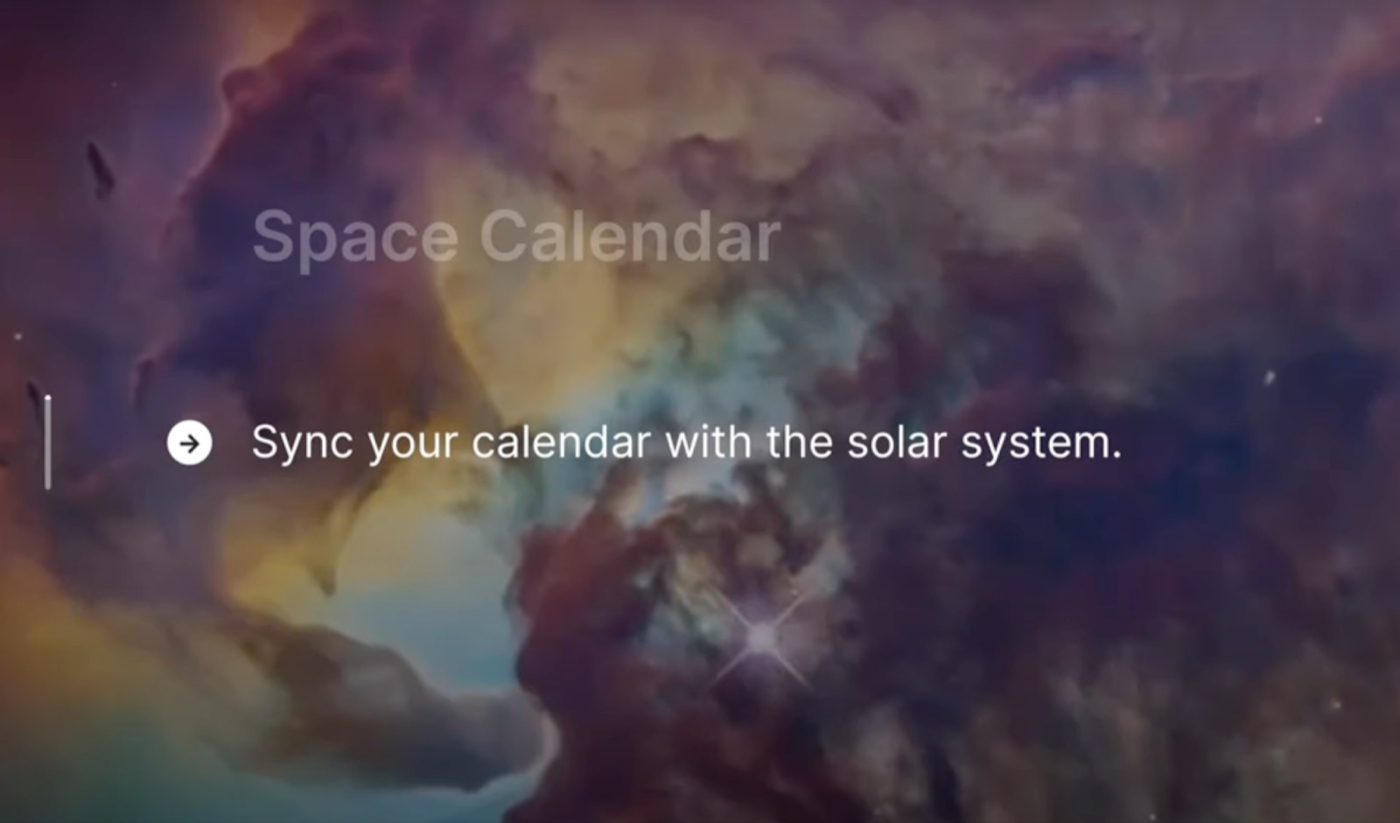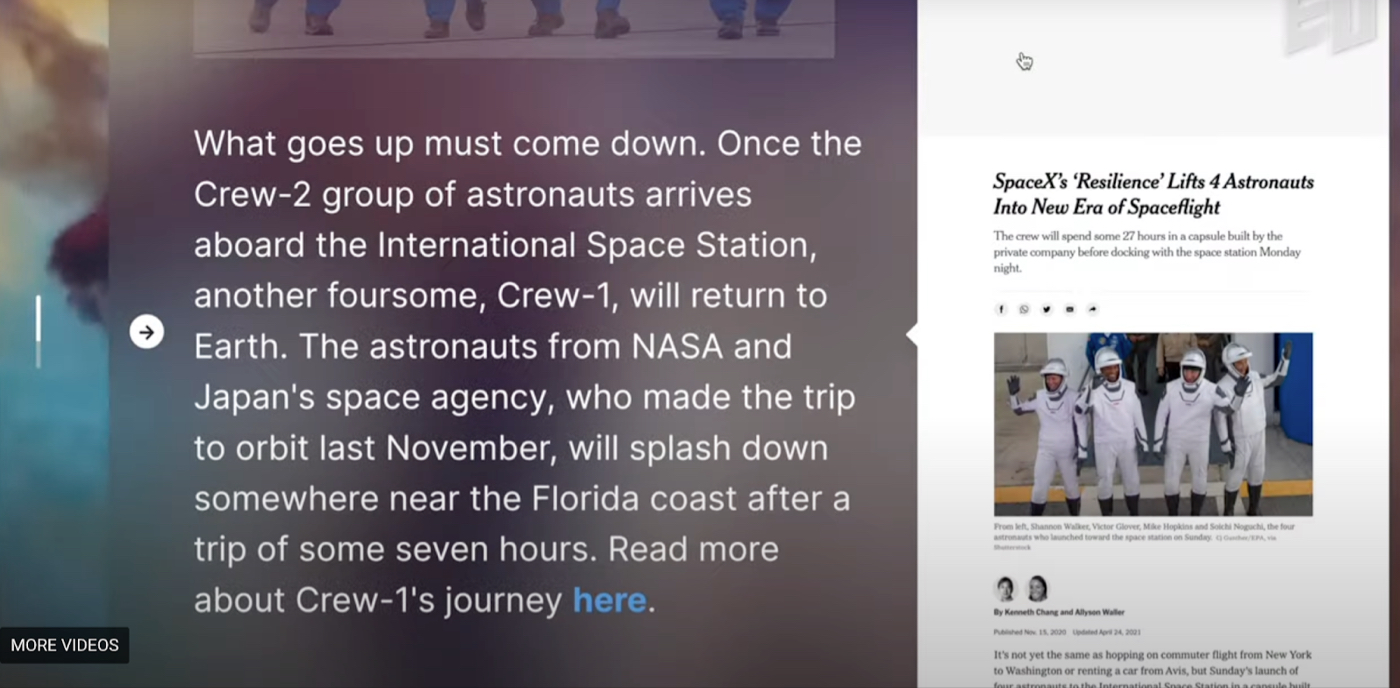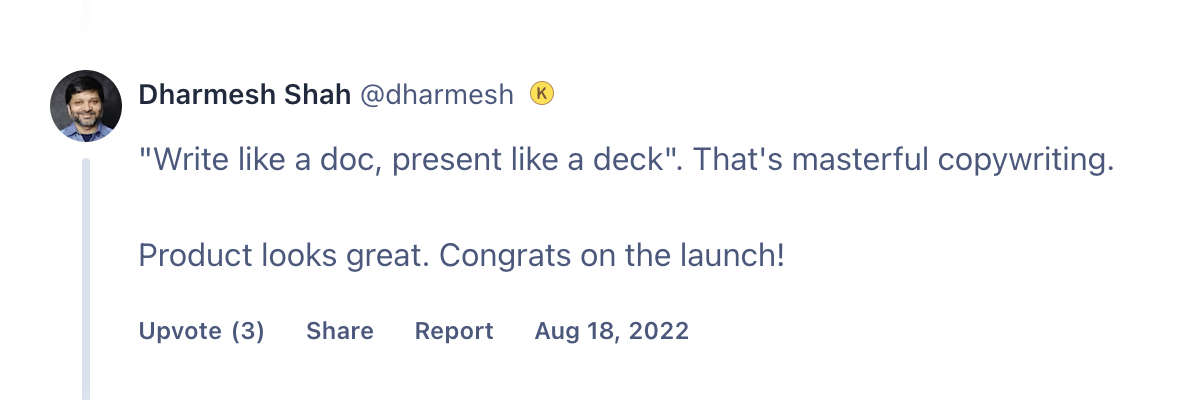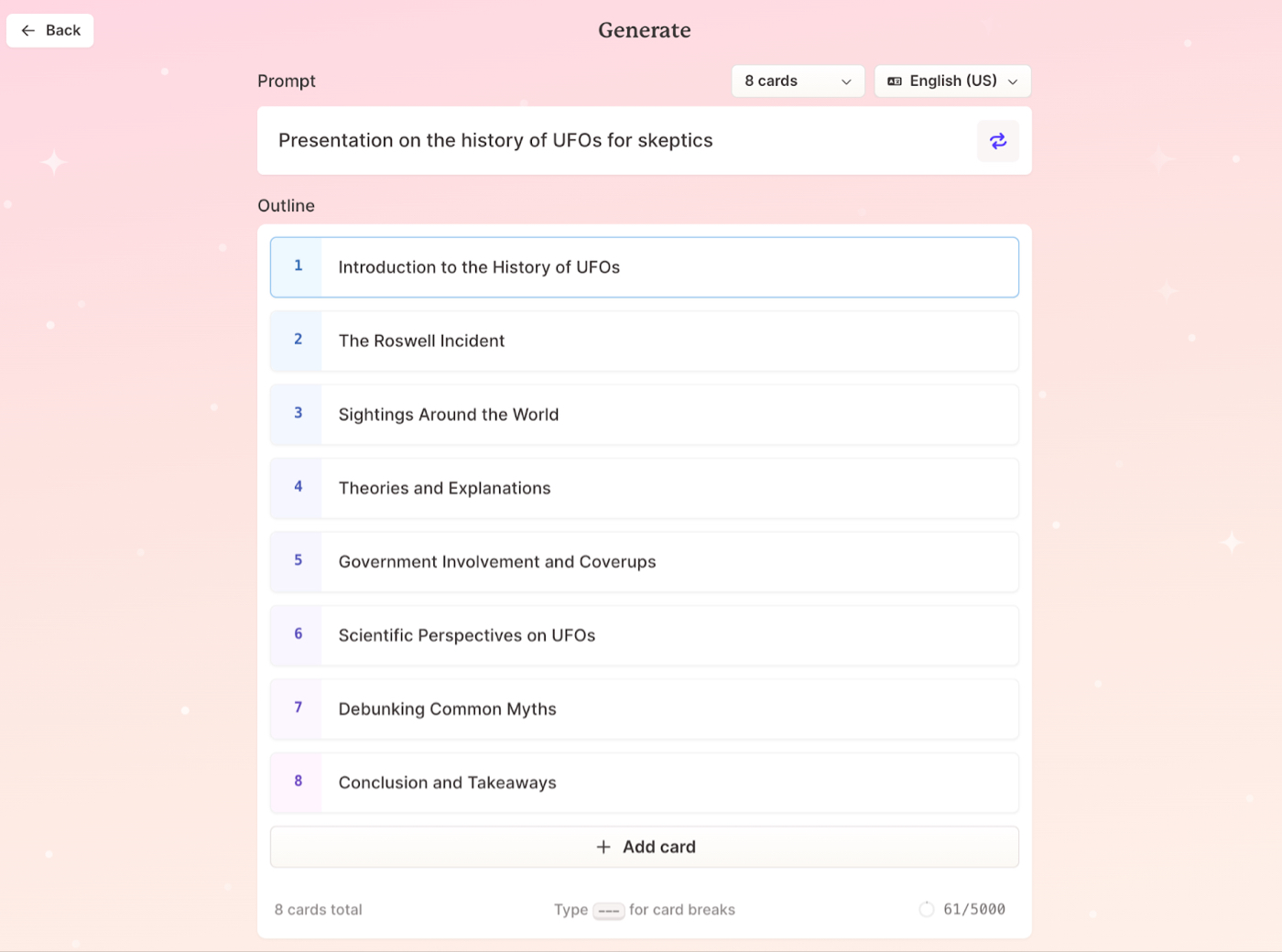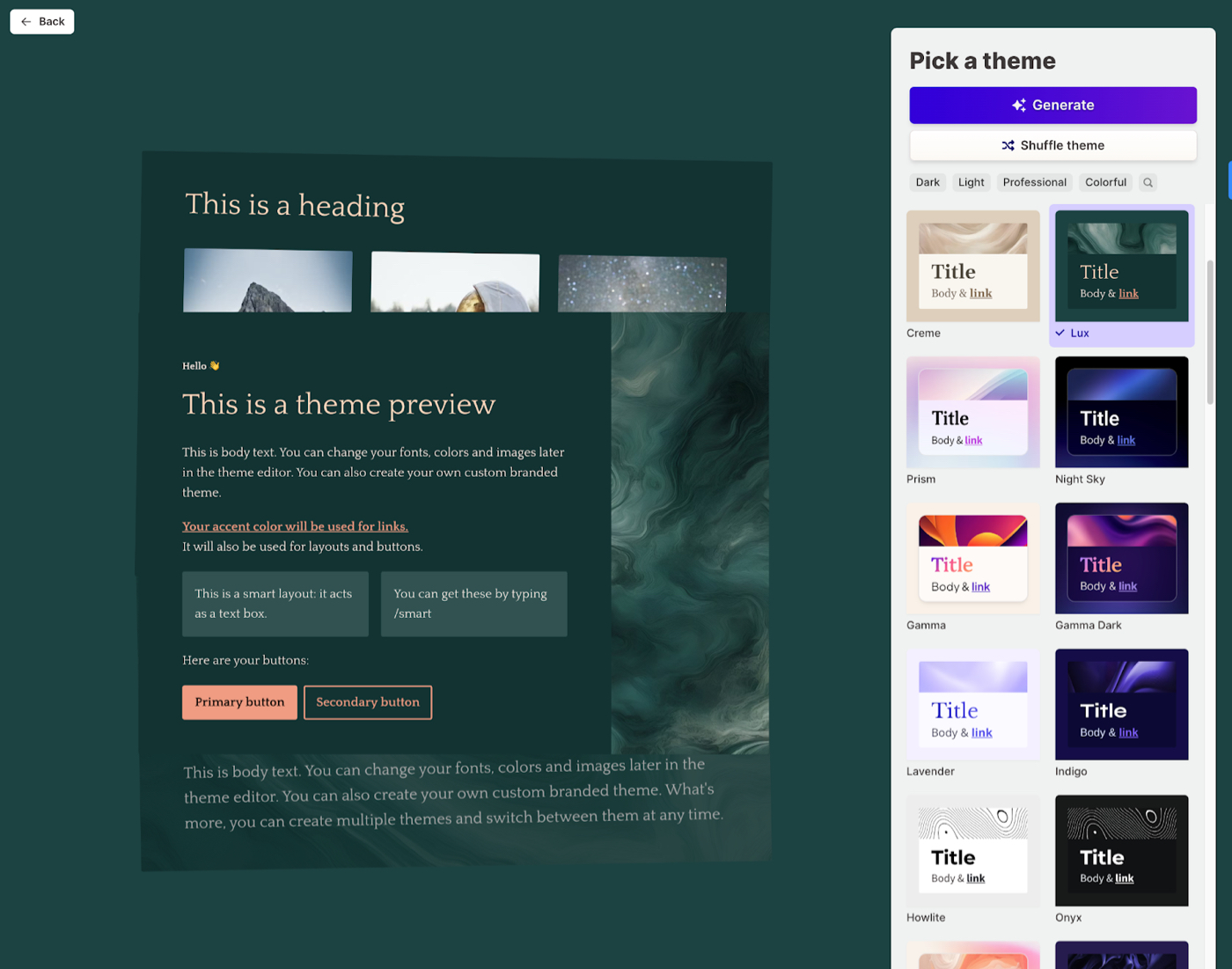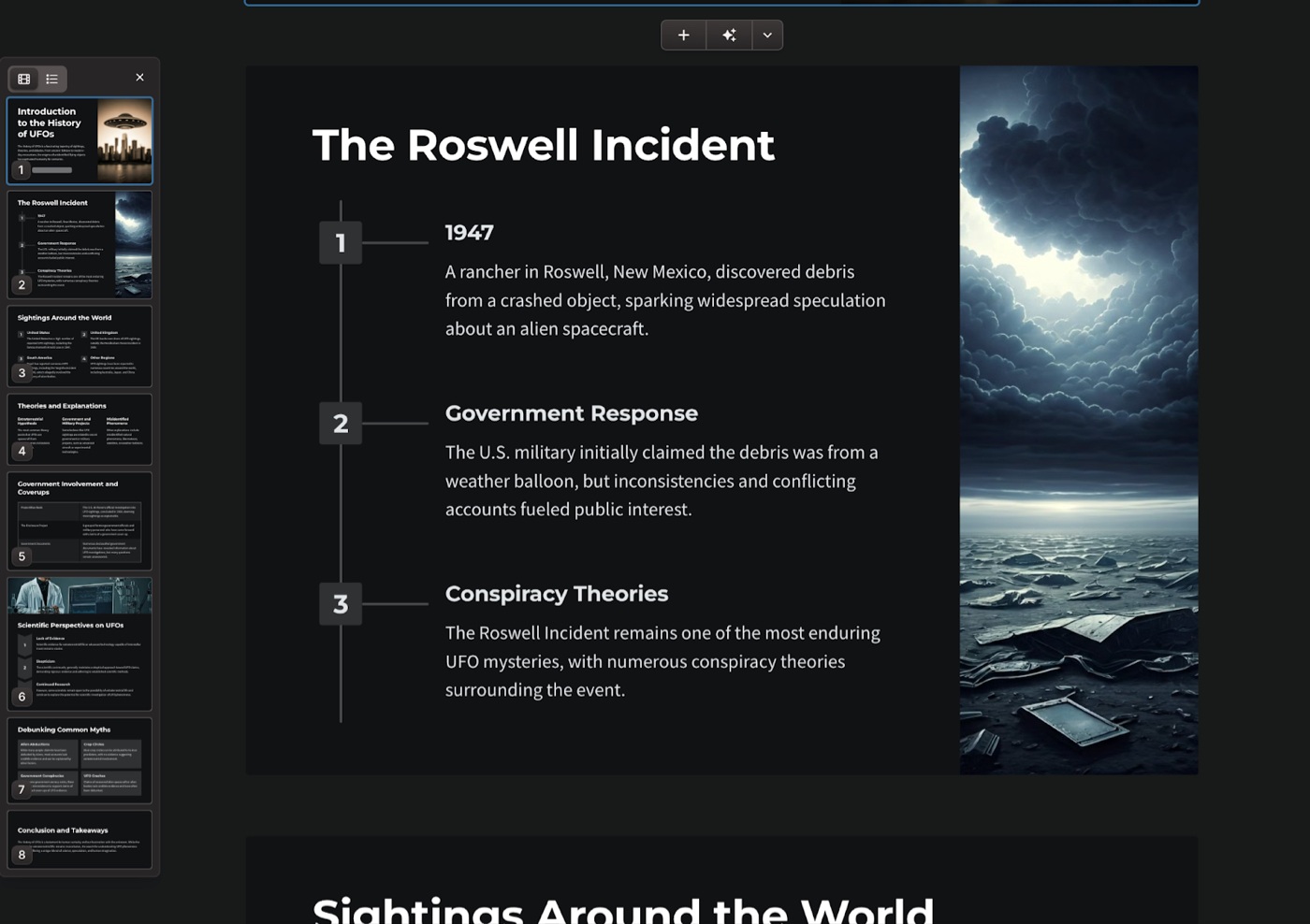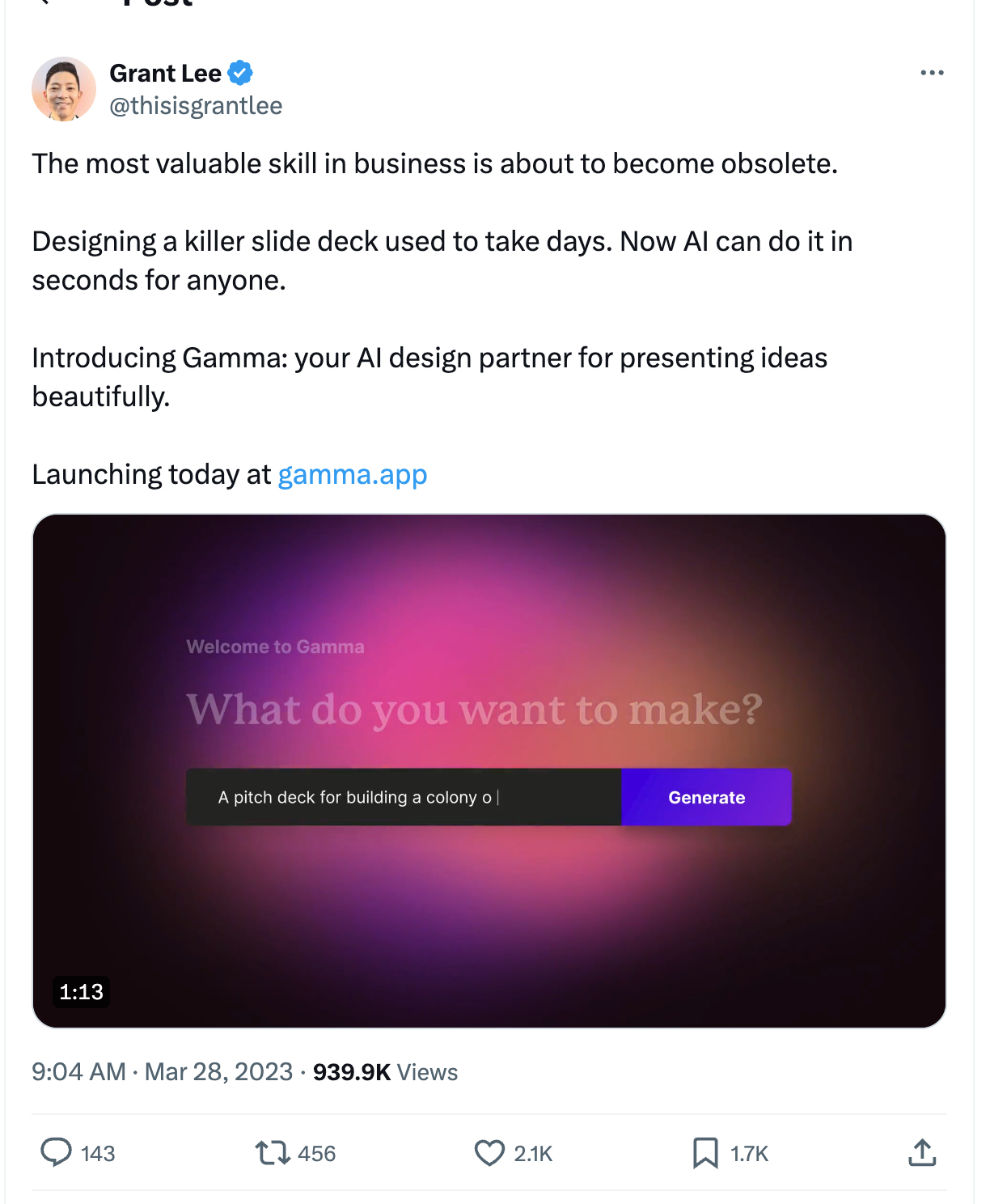
Pivots are tough. But as I argued two weeks ago, pivots are how the majority of Silicon Valley’s innovation bears fruit. So it’s heartening to read a story like Gamma’s—a company that was on the brink of failure before catching the AI wave at just the right moment. Jason Shen got up close with its founder, Grant Lee, whose steerage of Gamma from struggling startup to 3 million users in three months is a masterclass in how to execute a pivot. Read this piece to learn how to turn your startup's biggest weakness into its greatest strength. As go the pivots, so goes the Valley.—Evan Armstrong
As a startup founder and product manager, I've had to make a lot of slide decks. After I sold my last startup (Midgame, a voice-enabled AI assistant for gamers) I joined Meta, where I worked across multiple product teams and endured countless reorganizations.
Every reorg came with new team strategies, product roadmaps, and schedules for weekly meetings. I spent an embarrassingly large amount of time creating presentations to share what my team was working on to various stakeholders across the company. I used Google Slides templates custom-made by the company’s designers, but still found myself struggling to adjust font sizes and resize text boxes to fit all of the information.
As I grappled with these frustrations, a friend of a friend invited me to the private beta of a startup that wanted to rethink work presentations. Founded in 2020, it was called Gamma, and it promised a way out of my slide deck hell. Instead of being limited by the 16:9 frame of a standard slide, the product gave me the flexibility to express a point with as little—or as much—content as I wanted. It was much easier to use than Google Slides.
One of Gamma’s cofounders, Grant Lee, had been stuck in a presentation-heavy role as a startup operator and consultant and shared my frustrations. The small Silicon Valley-based team, members of which had previously worked together at A/B testing platform Optimizely, had raised $7 million in funding over two years to develop a “doc-and-deck hybrid,” as Lee told me.
Gamma launched its public beta in summer of 2022, reaching the number-one spot on the Product Hunt leaderboard and with tens of thousands of new users. But it had one big problem: Very few users were having a great first-time experience, and many did not return a second time. In product parlance, low activation was leading to poor retention—most people still found it too hard to create a presentation. And the startup’s clock was ticking because its financial runway was running out.
The Gamma team managed to execute a pivot, one that integrated AI into their product. It was so successful that, after their relaunch in March 2023, it gained 3 million users in just three months—many of whom were sticking around and paying for premium plans that allowed unlimited use of its AI-generation features.
Having attempted two pivots in my own startup journey, I’m fascinated with the twists and turns founders take to find that elusive product-market-fit. I’ve written extensively about the art of pivoting, including in my 2024 book The Path to Pivot, a playbook for founders trying to find a new meaning for their companies. Despite accounting for more than 80 percent of some investors’ biggest returns, successful pivot case studies are few and far between.
Gamma’s story is an important one for any founder operating in an industry that is constantly changing due to market conditions and emerging technologies. Let’s dive into how the company’s focus on solving its user’s “blank page problem” and well-timed AI adoption helped it graduate from a shiny toy to a rapidly growing disrupter.
Escaping the ‘print-and-project’ era
Grant Lee joined Optimizely in 2013 and spent five years at the company in finance and operations roles, rising to interim CFO. Eventually, he was recruited as COO of ClearBrain, a Y Combinator-backed causal analytics startup that was acquired by digital analytics platform Amplitude in March 2020. With the exit, Lee decided to try his hand at consulting and began to advise startups on growth and strategy. It wasn’t long before he was juggling multiple clients and assembling weekly presentations to update his clients.
“A lot of my time was spent communicating my findings,” he says. “You’d start in a doc, then move things over to a slide, and 90 percent of the time you’re just trying to make everything look presentable.”
Lee found that it was more time-consuming to wrestle with the copy and images for his projects in presentation tools like PowerPoint and Google Slides—even more so than completing the actual consulting work he was responsible for. The pandemic had turned life upside down for many knowledge workers who suffered from video-call fatigue and tech overwhelm. Suddenly there was a huge need to find ways to communicate efficiently and authentically through purely digital means.
To Lee, the pain point was clear. So he sought out his former colleagues at Optimizely —Jon Noronha, who was the vice president of product, and James Fox, a staff engineer—to build something from the nugget of his idea: a new canvas to present and share work information.
Over the next few months the trio analyzed and broke down how existing document editors and presentation tools like Google Docs and PowerPoint worked. These older tools didn’t tap into the responsive and interactive nature of software to find new ways to present ideas. Instead, they were simply digital parallels of their analog counterparts—printed pages and slide projections.
They decided that their initial prototype would be an editable page that could be advanced section by section, like scrolling through a parallax website—a user interaction style in which content that’s spatially in the front scrolls faster than content in the back, making the site feel three-dimensional.
Early versions of Gamma. Source: Gamma.The product introduced the idea of cards, which became a building block for future Gamma products. Unlike say a Powerpoint slide, which is of a fixed length and width (conforming to the physical constraints of a photographic film slide), a card can be any length and any height. It can also be capable of embedding a wide range of media, like images, videos, Loom screen recordings, presentation voiceovers, or even other websites.
The card broke free of the historic constraints of the page or the projector slide. The flexibility of the card interface to include short or long lengths of texts and images was reminiscent of the wildly innovative hypermedia development kit and app Hypercard—an early pre-web attempt by Apple to move beyond document and slide constraints that combined a flat-file database with a graphical, user-modifiable interface.
But I was also reminded of how their predecessors had failed. While I shared Gamma’s vision of a more interactive medium, I was worried about how they’d achieve it. After all, Google Slides and PowerPoint still dominate our presentation landscape.
Confronting the blank page problem
By spring 2022, the team had raised a $4 million seed round led by Accel. Their private beta had helped them gain confidence in their product, along with their dogfooding—Lee credits using the product internally as a critical path to understanding how it should evolve and grow. By doing so, they decided that Gamma should have a writing-based interface, which would help users better focus on expressing ideas first, as opposed to a canvas interface, where every element is independently resizable and adjustable.
They launched their first public beta in August and reached the number-one product of the day, week, and month on Product Hunt with the tagline, “Write like a doc, present like a deck.” The team stayed at the office until midnight the day of the launch to ensure everything went smoothly.
Over the next few months, tens of thousands of people signed up for the free product, whose hybrid document-deck nature drew praise from tech leaders like Hubspot CTO Dharmesh Shah and Maven founder Gagan Biyani. It seemed like all their hard work had paid off.
But they had a problem—activation.
Source: Product Hunt.
Lee believed that users were signing up because they were compelled by Gamma’s promise to help users make presentations that looked good without having to wrestle with formatting. But when users were prompted to actually create a new presentation on the spot, they hit what he calls “the blank page problem”: They had to come up with a presentation and figure out how to create it in this new tool that was neither a Google Doc nor a PowerPoint.
Many Gamma users would sign up but never actually create a presentation. User retention was in the single digits. When Lee spoke with his team about the product, they would reference OpenAI co-founder Sam Altman’s definition of product-market fit: ”Do any users love our product so much they spontaneously tell other people to use it?” By this measure, Gamma was still far off the mark.
They tried all sorts of things to improve user stickiness—targeting specific user groups like teachers or agencies, and experimenting with real-time collaboration features. At one point, they surmised that user onboarding was a possible culprit. Because Gamma was entirely different from existing presentation and document tools, new users might not know what to do once they signed up.
So the team tried making example Gammas to guide new users. At their weekly internal meetings, known as “Gammaramas,” a member of the team would present a Gamma on Steph Curry, a note-taking system, or the ambition of the Walt Disney Company. They also built templates in response to users who asked for them to help make sales proposals, marketing plans, and project kickoffs.
But while these iterations helped in marginal ways, Lee knew they needed to make a bigger push to fix their usage and retention problems.
AI ignites explosive growth for Gamma
Like many technologists, Lee had been playing around with early versions of large language models. Back in mid-2021, the technology's potential was still unclear.
"It never occurred to us that AI could really transform the creation experience, nor that that was where its real potential was,” he said in a 2023 interview. “That's something that I think dawned on us more over time as we built out the product.”
The team noticed significant leaps between OpenAI’s GPT-3 and GPT-3.5 models (the latter of which powered the initial version of ChatGPT). But it was the image generation abilities of Stability AI’s text-to-image model Stable Diffusion in mid-2022 that really got the team thinking. Letting users create images directly from text prompts could potentially solve Gamma’s blank page problem.
In the late winter of 2022, they got to work. Their goal was to create an AI-first experience that helped Gamma users create a presentation within the first five minutes of signing up. All you had to do was write a prompt like, “Presentation on the history of UFOs for skeptics.” In two clicks, the tool would produce an outline, offer a few visual style themes, and generate a fully-fledged presentation with headlines, bullet points, and images.
Gamma AI launched in March 2023 with a new tagline: “Your AI design partner for presenting ideas beautifully.” This time, there was no fanfare or anxious late-night monitoring. “We just flipped it on,” Lee recalls, “and things started growing like crazy.”
An example of Gamma’s create-first interface which quickly generated a presentation from a given prompt “Presentation on the history of UFO’s for skeptics.” Source: Gamma.The response to the launch video was massive—and strikingly clear. It received more than 5,000 reactions and 330 reposts on LinkedIn, and nearly 1 million views on X.
“On the day of the AI launch I thought we’d get some response, but honestly the numbers seemed almost fake,” Lee says. “We were quickly getting 5,000 sign-ups a day, then 10,000, then 15,000. We kept thinking it would stop, but it just kept growing to hundreds of thousands a day.”Gamma had competition, but no other startup building AI-forward presentation tools had achieved the same traction. And the retention curve had dramatically shifted—more than five times as many new users were hitting that magical threshold number of minutes spent continuously editing that eluded them previously.
With the AI release, they also had to figure out monetization—API costs add up quickly. Gamma gave every user 400 AI credits (enough to generate 10 presentations each with eight cards), asking them to email a customer support address if they wanted to pay for more. They figured they’d respond to any requests with a Stripe link to accept payment, which was a hacky way of “monetizing” the product but proved a willingness to pay.
When the first wave of payments came in for more AI credits—less than an hour after sending out the Stripe link—the founders knew they didn’t just have an interesting product. They had one that users were willing to fork over hard cash for. They had the elusive product-market fit they had been chasing.
The future of Gamma
By the summer of 2023, in just three months, Gamma acquired more than 3 million users. And the momentum has continued. As of March 2024, Gamma ranked number 16 in Andreessen Horowitz’s list of top generative AI companies based on unique web visits, just two spots behind the AI image generator Midjourney. Two months later, they announced a $12 million Series A fundraise led by their seed investor Accel. Sixty million Gammas had been created while they had just 16 employees. The company also became profitable.
The company isn’t satisfied with merely reinventing documents and presentations—they have ambitions to tackle larger problems in online publishing. In February 2024, Gamma introduced the ability to turn longform presentations into full-blown websites on a gamma.site subdomain for free or on a custom subdomain on a Pro plan.
Since the feature was released, 100,000 sites have been published on Gamma’s platform. (Here's one I made using the prompt “storytelling narrative frameworks for professionals in transition.”)
“Most people don’t know how to make a website,” Lee says. “Most website builders are still too hard to use, and the templates are fragile—they break easily.” A great-looking template often loses its shape once you get deeper, inserting too much or too little text, or using a portrait photo instead of a landscape one. Lee sees this frustration as an opportunity to squeeze into the competitive market of website builders with “a form factor people are already familiar with.”
Lessons learned from Gamma’s pivot
1. Catch incoming tech waves to find growth
When there’s a generational advancement in technology—like the web, mobile computing, or generative artificial intelligence—it’s worth seeing if you can try to catch the wave they produce. Doing so can be a risky maneuver, especially when you have limited resources and a small window to show progress to your investors. But it might jump-start a stalled startup like Gamma 1.0. The investor Paul Graham described it best: “Since the most successful startups generally ride some wave bigger than themselves, it could be a good trick to look for waves and ask how one could benefit from them.”
2. Make AI apps model-agnostic
Gamma believes it will succeed by creating easy and powerful interfaces and tools for office workers who need to create better documents and presentations, not by building the most advanced AI models. When new AI models come along that are faster, higher quality, or cheaper, the team can swap them. “When you see competitors building out teams of [machine learning] researchers and data scientists, it’s easy to second-guess yourself and wonder if you should be doing the same,” Lee said.
3. Invest in observability
Because of the inherent unpredictability of generative AI models, it’s important to have telemetry—usage and user data capture systems—to analyze whether they’re delivering value. Gamma tracked user inputs, system prompts, AI outputs, and user interaction with those outputs. “With AI you have to balance a lot of competing qualities, like speed versus quality,” Lee says. “You might generate an amazing image, but if it takes 30 seconds [to load], it doesn’t matter because the user will have left.”
4. Build and iterate toward user needs
On several occasions, Gamma has reversed course on product stances. During the pandemic, remote work placed new importance on building a collaborative multiplayer experience. But user testing taught them that it was far more useful to have an excellent single-user experience.
Similarly, Lee was adamant that Gamma would become the final destination for their users. He believed that allowing content to be exported was a poor use of resources. “I would tell VCs when we were pitching that PDF export was the last feature I would ever build,” Lee said. “But then right away people were asking for the ability to export to PDF. As much as you want to be an innovator, you need to meet your users where they are.” The feature launched sometime after my first exploration of their private beta in mid-2022, when I ran into the same concern: If Gamma fell onto Meta’s banned tools list (Loom, for instance, was not approved), I’d have to recreate the presentation I made from scratch—a risky proposition.
AI has opened up a new world of pivots
Gamma pivoted because the company was losing users to the paralyzing fear of a blank page. Lee and his colleagues quelled this fear with AI—while still letting users feel like they made the decisions for their presentations themselves. Their updates to the product struck a delicate balance between automation and user agency. Of all the factors in the company’s success, the most important one was catching a major tech wave at just the right time.
AI engages the IKEA effect, which holds that people attribute higher value to things they have made themselves—whether that’s assembled furniture, origami, meals, or presentations. But just like making dinner is easier when you have already portioned the meal kit, it helps when another entity does some of the heavy lifting on your behalf. Prompting and selecting the visual look and feel of presentations drove up how much users valued the presentation they ultimately co-created with Gamma’s AI.
The instinct to integrate AI has been invaluable to Gamma’s success. As AI becomes ubiquitous, remember that the value it adds to a business is not the technology itself, but how you can leverage it to solve actual user problems to set your product apart.
Jason Shen is a three-time startup founder, an executive coach, and the author of The Path to Pivot.
To read more essays like this, subscribe to Every, and follow us on X at @every and on LinkedIn.
